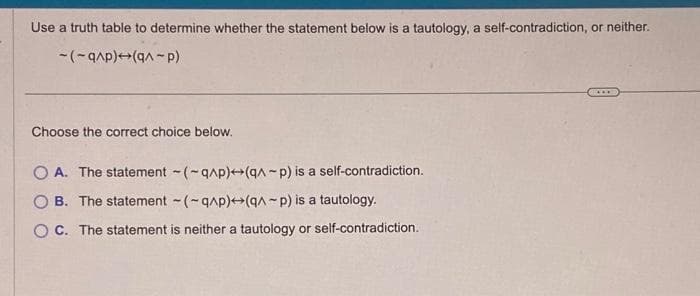Use a truth table to determine whether the statement below is a tautology, a self-contradiction, or neither. -(-q^p) (q^-P) Choose the correct choice below. OA. The statement ~(~q^p)(q^~p) is a self-contradiction. OB. The statement ~(~q^p)+(q^-p) is a tautology. OC. The statement is neither a tautology or self-contradiction. ***
Use a truth table to determine whether the statement below is a tautology, a self-contradiction, or neither. -(-q^p) (q^-P) Choose the correct choice below. OA. The statement ~(~q^p)(q^~p) is a self-contradiction. OB. The statement ~(~q^p)+(q^-p) is a tautology. OC. The statement is neither a tautology or self-contradiction. ***
Algebra for College Students
10th Edition
ISBN:9781285195780
Author:Jerome E. Kaufmann, Karen L. Schwitters
Publisher:Jerome E. Kaufmann, Karen L. Schwitters
Chapter2: Equations, Inequalities, And Problem Solving
Section2.6: More On Inequalities And Problem Solving
Problem 68PS
Related questions
Question
Subject: algebra

Transcribed Image Text:Use a truth table to determine whether the statement below is a tautology, a self-contradiction, or neither.
-(-q^p) (q^-P)
Choose the correct choice below.
OA. The statement (-q^p)+(q^-p) is a self-contradiction.
OB. The statement (-q^p)+(q^-p) is a tautology.
OC. The statement is neither a tautology or self-contradiction.
Expert Solution
This question has been solved!
Explore an expertly crafted, step-by-step solution for a thorough understanding of key concepts.
This is a popular solution!
Trending now
This is a popular solution!
Step by step
Solved in 3 steps

Recommended textbooks for you

Algebra for College Students
Algebra
ISBN:
9781285195780
Author:
Jerome E. Kaufmann, Karen L. Schwitters
Publisher:
Cengage Learning

Intermediate Algebra
Algebra
ISBN:
9781285195728
Author:
Jerome E. Kaufmann, Karen L. Schwitters
Publisher:
Cengage Learning

Algebra for College Students
Algebra
ISBN:
9781285195780
Author:
Jerome E. Kaufmann, Karen L. Schwitters
Publisher:
Cengage Learning

Intermediate Algebra
Algebra
ISBN:
9781285195728
Author:
Jerome E. Kaufmann, Karen L. Schwitters
Publisher:
Cengage Learning